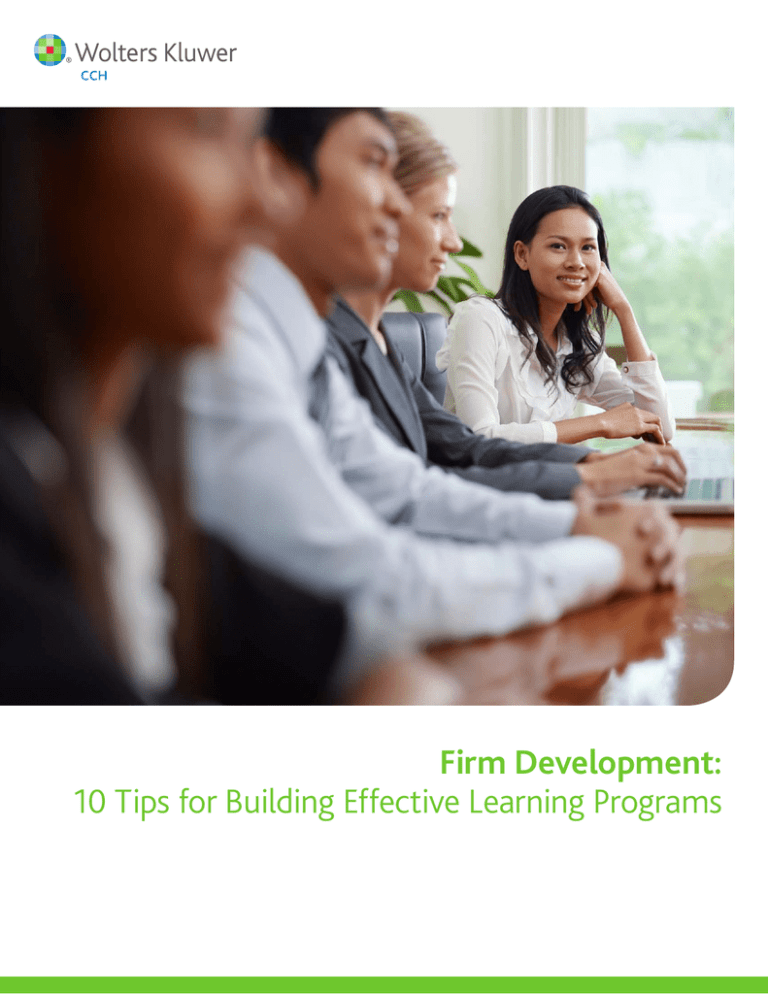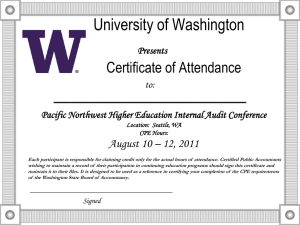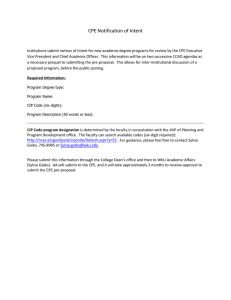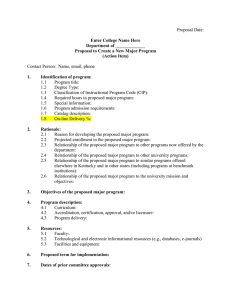
Firm Development:
10 Tips for Building Effective Learning Programs
Tip #1: Find a Learning
Administrator
To build an effective education strategy for
your professionals, you’ll need a learning
administrator to take the lead. It’s a
challenging role that requires knowledge
about how adult professionals learn as well
as an understanding of accounting firms.
How a firm decides to fill the role of
learning administrator depends largely
on the size of the firm and its available
resources. Most firms follow one of
three paths when establishing someone
to head their learning program:
Hire a full-time learning professional.
If your firm hires a dedicated training
professional, you’ll benefit from expertise
in curriculum planning and training
design. This can lead to more effective
presentations, especially for in-house
training. A learning and development
professional will bring fresh ideas from
other industries, companies or firms.
He or she will probably not be an
accountant — this person will start from
scratch designing an effective curriculum
based on proven learning principles.
Put an internal manager or partner
Introduction
Firm managers understand that lifelong professional development is
essential for maintaining a top-notch accounting staff. Continuing education
is a technical requirement of professional licensure for CPAs and CFPs and
is necessary in order to keep up with the latest changes in legislation and
technology. A robust learning program is also a very good way to attract
talented professionals to your firm. Last, but definitely not least, welltrained professionals do the best possible job for your firm. Competence
and confidence enables them to increase client service levels, generate
more billable work, and ultimately,drive more revenue for your firm.
In spite of these compelling reasons for professional development,
many firms don’t have a dedicated learning administrator or formal
curriculum in place. This guide provides best practices to help you
develop a learning program and answer questions such as:
How can our firm best leverage learning programs to develop our
professionals, attract and retain talent and grow our firm over time?
How do we develop the right curriculum?
What content do we need? Should we buy it or build it?
How can we best leverage technology to manage and track training programs?
2
in charge. Depending on available
resources, promoting from within
could involve a full-time learning and
development position or become
an additional responsibility for an
existing administrative role. If you
select a learning administrator from
existing staff, he or she may not have
much training experience. But she will
have experience in your accounting
firm and already understands its
culture and learning needs.
Work with a learning consultant.
Specialty consultancies and some
large accounting firms offer “training
as a service” for small or mid-size
firms that lack the resources for
an in-house administrator. These
consultants are experienced trainers
and can help develop curriculums.
Learning professional Linda Steele
manages Great Minds, LLC—a firm
dedicated to helping accounting firms
with curriculum planning and training.
She has found that firms with fewer
than 80 employees generally can’t
afford a full-time learning administrator.
SPOTLIGHT:
Learning Administrator —
Kathie Rotz
FIRM: Honkamp
Krueger & Co., P.C.
LOCATION:
Iowa (3 cities),
Wisconsin and
Missouri
BACKGROUND:
15+ years in corporate training
CURRICULUM ADVICE:
When creating content, use
checklists to remind you of the
six trumps that make content
engaging across all learning styles.
TRAINING TIP:
Train the trainers. Help your firm’s
subject matter experts develop
presentation styles that engage
learners and incorporate humor.
“Trainers are constantly justifying their
positions,” Steele explained. “Training,
marketing and HR professionals can
be a hard sell in accounting firms
because they are not billing hours.”
Tip #2: Determine
Objectives
To determine the objectives for your
firm’s learning program, first take stock
of business goals. Then determine
whether training is appropriate for each
goal. Next you’ll meet with employees
to see what they believe is needed
and you’ll want to evaluate those
suggestions against business goals.
Survey all of your firm’s employees —
from administrative assistants to
partners — to discover what learning
is needed at your firm and to identify
critical knowledge gaps. Find out what
people in each role need to learn in
order to deliver results for the firm.
What technical knowledge is required?
What are the professional certification
requirements? What technology is
employed? How do these professionals
learn firm workflows? What soft skills,
such as leadership or customer service,
would help? Turn the results of this
survey into specific, achievable learning
objectives for each role in your firm, at
varying levels of seniority.
Additionally, meet with firm management
to find out whether the firm faced any
tough hurdles over the past year. What are
the lessons learned from the perspective
of additional training needed? Would
it be beneficial to develop an employee
training based on some specific client
case studies related to these challenges?
Tip #3: Create Formal
Learning Curriculums
Based on the learning objectives
you have defined, develop formal
learning curriculums. Sometimes
described as “learning ladders”,
these curriculums provide a clear
path for each employee to follow for
professional and career development.
In some firms, continuing education
is really just about obtaining CPE to
maintain a CPA license as quickly and
inexpensively as possible. But this is not
a strategic use of time, money, or human
resources. “If a firm has more than one
employee, growth is necessary for every
single person,” cautioned Kathie Rotz,
the training services manager
for Honkamp Krueger & Co., P.C.
“If you’re just trying to meet a
requirement and get it out of the way,
there’s often no true learning.”
Both firms set up curriculums based
on roles or specializations within the
firm, with variations based on
seniority level. At Briggs & Veselka,
for example, partners are encouraged
to complete most of their CPE outside
the firm at conferences where they
can also build professional networks;
less senior employees take more
training in-house and online.
Employees with clear objectives who
are cultured to learn will be more
productive and knowledgeable. They
will have the skills and ability to better
engage clients, raising satisfaction and
growing firm revenues by recommending
complementary services.
A robust training curriculum can also
be an effective tool for recruiting and
retention. “We hope all of our young
accountants will become certified. So
even if they aren’t CPAs, we’ve put in
place a firm requirement that emulates
the state of Texas annual CPE requirement
for CPAs. From first-year staff members
to shareholders, they all have the exact
same CPE requirement — at least 40
hours per year,” shared Catherine Loftis,
compliance manager at Briggs & Veselka.
CCH® Learning Center
Offers 14 Complete,
Industry-Specific
Curriculums
CCH® Learning Center is an online
professional development resource
for accounting firms provide
complete continuing education
to employees and keep up with
legislative changes and industry
developments. It provides curriculum
paths designed to direct learners to
the most relevant courses for their
specific needs. These 14 industryspecific curriculums include:
Accounting
Auditing
Compilation and Review
Corporate Income Taxation
Financial and Estate Planning
Fraud and Ethics
GAO Yellow Book
Individual Income Tax
Pass-Through Entities
Sales and Use Tax
Small Business Income Tax
State Income Taxation
Trust Taxation and
Estate and Gift Tax
U.S. and International Taxation
3
SPOTLIGHT:
Learning Administrator —
Catherine Loftis
FIRM:
Briggs & Veselka Co.
LOCATION:
Houston, Texas
SIZE:
164 professionals
BACKGROUND:
Accounting firm administration
CURRICULUM ADVICE:
Make younger, unlicensed
professionals adhere to the
same CPE requirements as
the CPAs in your firm, so they
develop good learning habits.
TRAINING TIP:
Toastmasters International is a
great resource for developing
your presentation skills.
Tip #4: Improve New
Hire Training
One curriculum that every firm should
prepare is for onboarding new employees.
New hire training should spend a couple
days acclimating to the firm’s culture
and general operational items, and then
finish the onboarding week (or longer)
learning about the firm’s specific workflows,
such as how to prepare a tax return or
an audit, and how to use the software
systems that support those workflows.
After you’ve developed an initial onboarding
curriculum, put your current staff through
the training, too. Don’t assume existing
employees already know every process
or execute workflows in the way the firm
recommends. You may be surprised at
the additional productivity gained when
everyone attends the same training.
Tip #5: Everyone
Learns Differently
Once your firm’s objectives and
curriculum are defined, it’s time to
decide where you will find your training
content. It’s important to keep in mind
that everyone learns differently — some
prefer to read; others prefer to hear.
4
Some like self-study; others need a
classroom or live group environment.
You can bring multiple types of
learning into one course by employing
a mixture of podcasts, presentations,
videos, live webinars and self-study.
Informal learning is important to your
firm. Not everything learned needs
to count toward CPE requirements.
Consider setting up firm-wide “how-
to” wikis or other types of enterprise
social media to exchange thoughts
and empower subject matter
experts to continually educate.
Build Vs. Buy Content
Firms can choose to create their
own content, purchase courses from
external learning providers, or leverage
the best of both sources. According to
the American Society for Training and
Development (ASTD), U.S. organizations
spent more than $150 billion on
employee learning in 2011. Of this, 56
percent was spent on internal training
and 30 percent on external services.1
The “build-or-buy” decision is usually
driven by cost and quality of available
courses. Building your own course
requires your firm to develop course
materials, comply with state requirements,
and perform recordkeeping including
maintaining attendance sheets and
issuing certificates of completion.
AccountingWeb recently asked firms
about their preferences for developing
content in-house or purchasing it from
a provider. The survey revealed different
benefits and drawbacks for each method:2
Many firms, including Briggs & Veselka
and Honkamp Krueger, choose to leverage
a blend of internal and external training.
They present live webcasts or virtual on-
demand content to a group of professionals,
and then follow up with an in-house
discussion of how the material should be
applied in the specific context
of the firm. In other instances, firms
develop an entire course from scratch —
for example Briggs & Veselka develops
annual updates for their accounting,
audit and tax departments and
Honkamp Krueger creates approximately
80% of their technology training
and soft skills courses.
Tip #6: Use the “Six Trumps”
to Facilitate True Learning
If you are developing your own curriculum,
you need to ensure that your firm’s
professionals will enjoy the class and
remember what they learned. The trainer’s
presentation will need to effectively
engage people with different learning
styles. Knowing what learning methods
and media “trump” the standard lecture
is key to creating a more dynamic learning
environment for your professionals.
According to Sharon Bowman, these
are the Six Trumps of Learning 3
1. Movement trumps sitting —
Get learners out of their chairs and
moving around at least every 10-20
minutes. Exercise gets blood flowing
and stimulates the brain.
2. Talking trumps listening — Talking
is interactive and more conducive to true
learning than lectures. When discussing
what they’ve heard, learners triple process
the information — first by listening, then
by thinking, and finally by restating it.
3. Images trump words — The human
brain remembers images better than
words, hence the old adage “a picture
is worth 1,000 words.”
IN-HOUSE TRAINING
EXTERNAL PROVIDER
PRO: Content is tailored for your firm.
PRO: There’s an opportunity to learn
from top experts in the industry.
PRO: You can conduct the training
during your firm’s less busy times.
PRO: Provider responsible for
course compliance.
PRO: You may be able to offer CPE to
some of your business clients as a benefit,
or additional revenue stream.
PRO: Offsite training and conferences
are a good networking opportunity.
CON: You must maintain compliance
with state licensing requirements.
CON: Subject matter is generalized.
CON: A lot of time and effort goes
into creating a new course.
CON: Your firm is subject to the
places, dates, and times course is offered.
Potential new revenue stream —
SPOTLIGHT:
Learning Administrator — Linda Steele
FIRM: Great Minds, LLC — a partnership with Abacus CPAs
and Wilson Toellner that provides in-house training for small to
midsized firms. Steele writes the curriculum and conducts training.
BACKGROUND:Steele has more than 20 years of corporate training experience and
has focused on accounting firms for the past 16 years.
CURRICULUM ADVICE: Accounting firms should conduct at least one full week
of new hire training, including deep dives into the software systems that new
professionals will use every day.
TRAINING TIP:Local colleges can be a good resource for in-house training about
regulatory changes, and occasionally they will provide training for free.
4. Writing trumps reading — Writing
requires total concentration and is both
intellectual and tactile at the same time.
5. Shorter trumps longer — Memory is
enhanced by “chunking” information into
smaller, manageable pieces. For complex
topics, engage in very concise reviews
throughout the class.
6. Different trumps same — Human
brains pay more attention to change,
so switch things up throughout the class
by alternating speakers, activities, and
media such as video clips.
Tip #7: Discover Your
Firm’s Subject Matter
Experts and Use Them
Your firm is probably full of brilliant
professionals who have plenty of
experience and insight to share with
their colleagues. As Kathie Rotz pointed
out, the tricky part is “to educate subject
matter experts that adults learn differently
than kids. Most speakers rely on their
own experiences in school. But adults
don’t want lectures and 5,000-word
PowerPoint® slides… So we’re lightening
it up a bit and keeping people engaged.”
Catherine Loftis discovered an effective
way to help firm employees polish up
presentation skills. Her firm hosts a
Toastmasters International club, teaching
public speaking and leadership skills
that build confidence. “Even though
Toastmasters is known for being a public
speaking club, meetings also focus on
delivery, evaluation, creating effective
presentations, as well as knowing and
engaging your audience,” she explained.
1
Tip #8: Consider
NASBA Certification
If your firm is going to develop inhouse CPE courses, you might want
to consider applying for certification
from the National Association of State
Boards of Accountancy (NASBA). This
certification enables you to conduct CPE
training in any state. If the CPE compliance
requirements of your State Board of
Accountancy are more flexible or less
costly than NASBA, you may not want
to pursue certification. But if your firm
has offices or employees across several
states, becoming NASBA-certified may be
easier than registering each course with
multiple State Boards of Accountancy.
Benefits of becoming NASBAcertified include: 4
Recognized compliance and
quality — NASBA-certified learning
providers comply with uniform
standards for continuing education
in the accounting profession.
National CPE, rather than state-
by-state — Certified programs
register on a national basis.
Qualified by the IRS — The IRS
permits NASBA-certified providers to
use an abbreviated registration process
for approval to offer programs to IRS
Registered Tax Return Preparers.
Laurie Miller, “ASTD 2012 State of the Industry Report: Organizations Continue to Invest in
Workplace Learning,” American Society for Training and Development, November 8, 2012.
2“Striking a balance: In-house and external CPE,” AccountingWeb, August 23, 2010.
Registered CPE program sponsors can
provide CPE to their clients and other
accounting firms. If you’re looking for
external sources of content, consider
making NASBA-certification one of
your requirements for any new learning
provider. That way, you can be assured
that the CPE you purchase will work for
all of your professionals, in any location.
Tip #9: Don’t Forget
Soft Skills
There’s a lot more to success in business
than numbers. Most professionals receive
a lot of training in accounting-related
topics but not so much in other softer
skills, such as client service or email
etiquette. Most learning administrators
would agree that leaving soft skills out
of your firm’s curriculum would be a
big mistake.
“Naturally these people are very
technical — like doctors or engineers,
they’re very technical, highly intelligent
and really know their stuff,” said Kathie
Rotz. “The people-relationships sometimes
don’t come as naturally as the numbers.”
Some of the most popular soft skills
courses at Honkamp Krueger are dining
etiquette and a class about the differences
between generations — a hot topic
as Baby Boomer accountants retire.
Learners in the emotional intelligence and
habits classes have to dig a little deeper.
“These are topics that are so valuable
in terms of everyday relations with
clients and coworkers,” asserted Rotz.
BRIGHT IDEA:
Lunch and Learns
Briggs & Veselka provides
professionals with free lunch and
plenty of interaction during lunch
and learn sessions. The group
gathers in a room and watches a
webinar, then talks over the material.
“This provides employees the
opportunity to network in-house.
In addition, if there’s continued
discussion or something needs to
be clarified then everybody has an
opportunity to discuss it before
they walk away,” said Loftis.
3
Sharon L. Bowman, “Six Trumps: The Brain Science That Makes Training Stick,”
4
NASBA website
5
BRIGHT IDEA:
Train the Trainer
To help her firm’s resident experts
develop better presentation skills,
Rotz instituted a “train the trainer”
program. Train your firm’s experts
by first explaining the basic science
of learning and attention. Rotz
suggests providing pointers on how
to engage an audience and inject
humor into potentially dry topics
in accounting. Offer to conduct
“practice runs” with your presenters
and give honest feedback.
Tip #10: Insight,
Measure and Adjust
Feedback is a critical aspect of finetuning your training curriculums that
is sometimes overlooked. Feedback
is insight that you can measure
with course evaluations and use
to adjust your curriculums as you
move forward. Feedback also helps
you discover when the development
needs of the firm may be changing.
Trainers should facilitate discussion
and feedback during the class,
tweaking it to the group in the room
if possible. Linda Steele always begins
her etiquette class with a quiz so she
can find out what learners already
know and where they need help.
After a course has been completed,
elicit feedback from your professionals.
Was the trainer effective? Was the
content useful? Make gathering
this feedback part of your standard
training process for both in-house
and external training.
At least once each year, your firm’s
learning administrator should circulate
a firm-wide survey about what new
topics employees would like to see
offered. Finally, the administrator
should take time to provide feedback to
external providers, so they can improve
content and eliminate bad instructors.
Bonus Tip: Use Technology
to Help Plan Curriculums and
Track Learning Objectives
Does planning several levels of curriculum
for each type of professional in your
organization sounds daunting? It is!
Tracking state licensing requirements
and each professional’s CPE is also
time-consuming. Fortunately,
technology can add efficiency to
both of these essential processes.
A learning management system (LMS)
can help learning administrators stay on
top of compliance and record-keeping
requirements and ensure that learning
objectives are being met. Many firms
track CPE for each professional with
spreadsheets, but an LMS offers distinct
advantages, including the ability to:
CCH Delivers
Industry-Leading Content
CCH Learning Center features more
than 300 self-study CPE courses on
timely and important topics, plus
training for CCH technology solutions.
CCH also presents hundreds of
seminars each year. CCH Seminars
are an easy and cost-effective way to
provide timely, practical training to
your firm on the latest tax, accounting
and auditing issues. Requiring no more
than an Internet connection, these
live, two-hour interactive sessions
are hosted by some of the industry’s
leading experts and are designed to
keep accounting professionals up to
date on new and emerging topics.
Set up multiple curriculum plans
Access current state licensure
requirements for all 50 states
across relevant certifications
Track individual progress against
CPE/curriculum requirements
Let professionals review their own
CPE objectives and completed courses
Receive automated alerts of
impending certification deadlines
Send out training reminders
Conclusion
Your firm’s learning needs will continue
to change and evolve as your firm
offers new services to clients, hires new
professionals, and tries to keep up with
ever-expanding legislation. Professional
education needs to be a purposeful part
of your firm’s business strategy — not
just a requirement for keeping a CPA or
CFP license. Identify a dedicated learning
administrator, create a formal curriculum
and adopt useful, efficient technology in
order to transform your firm’s learning
program into a true competitive advantage!
Track CPE and Requirements with CPE Assistant™
Connected to CCH Learning Center, CPE Assistant™ is also part of CCH Learning
Center. CPE Assistant is a learning management tool that reduces the time and cost
of maintaining a firm’s CPE compliance records. This online CPE management tool
tracks individual progress against CPE requirements and ensures that employees
maintain their certifications. It also provides complete and updated rule summaries
for all 50 CPA regulatory bodies mandating CPE, plus CLE, CFP and more.
For More Information
CCHGroup.com
800-CCH-REPS (888-224-7377)
All trademarks and copyrights are property of their respective owners.
6/13 2013-0303
Join us on
at CCHGroup.com/Social
©2013 CCH and/or its affiliates. All rights reserved.







